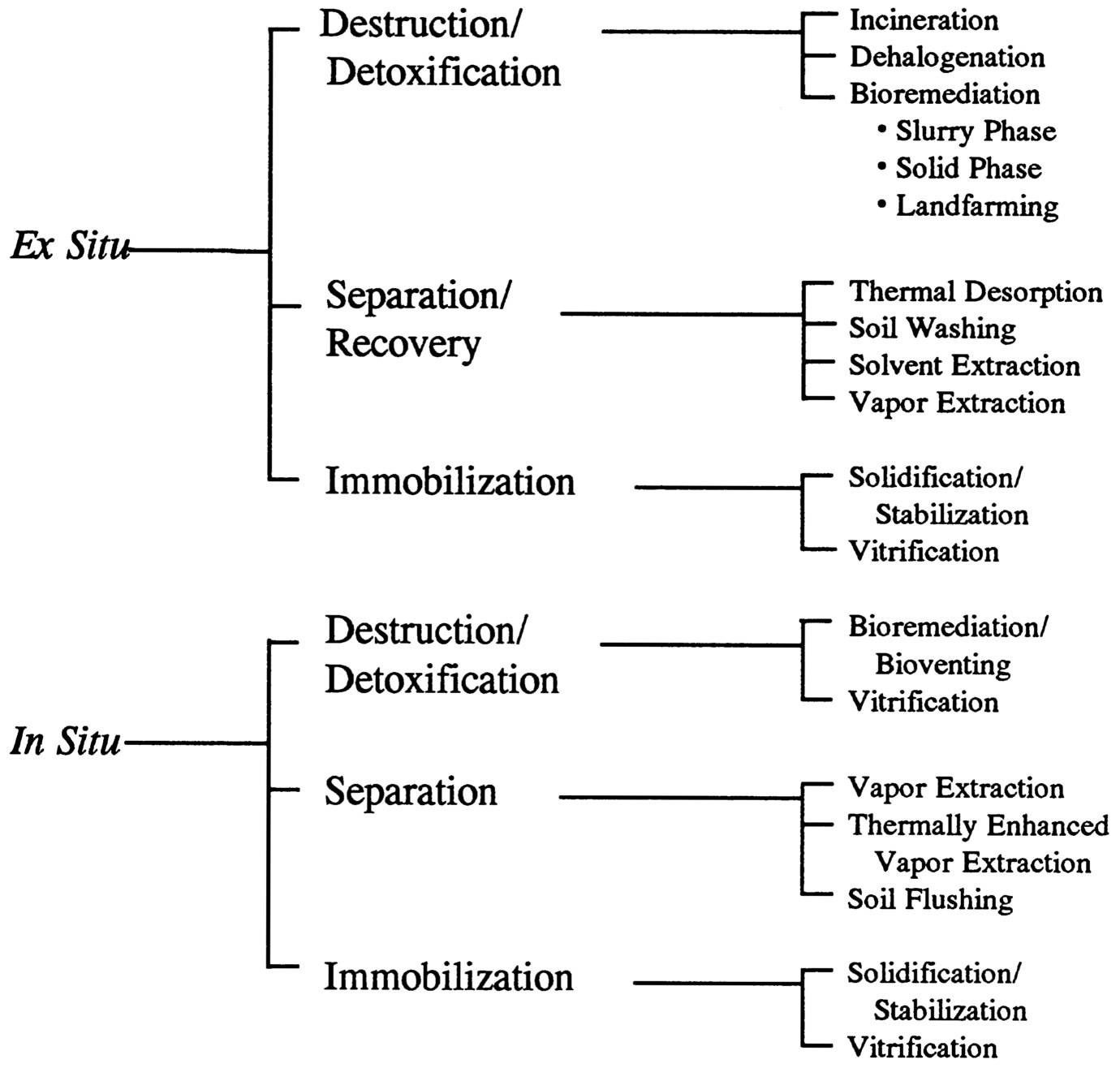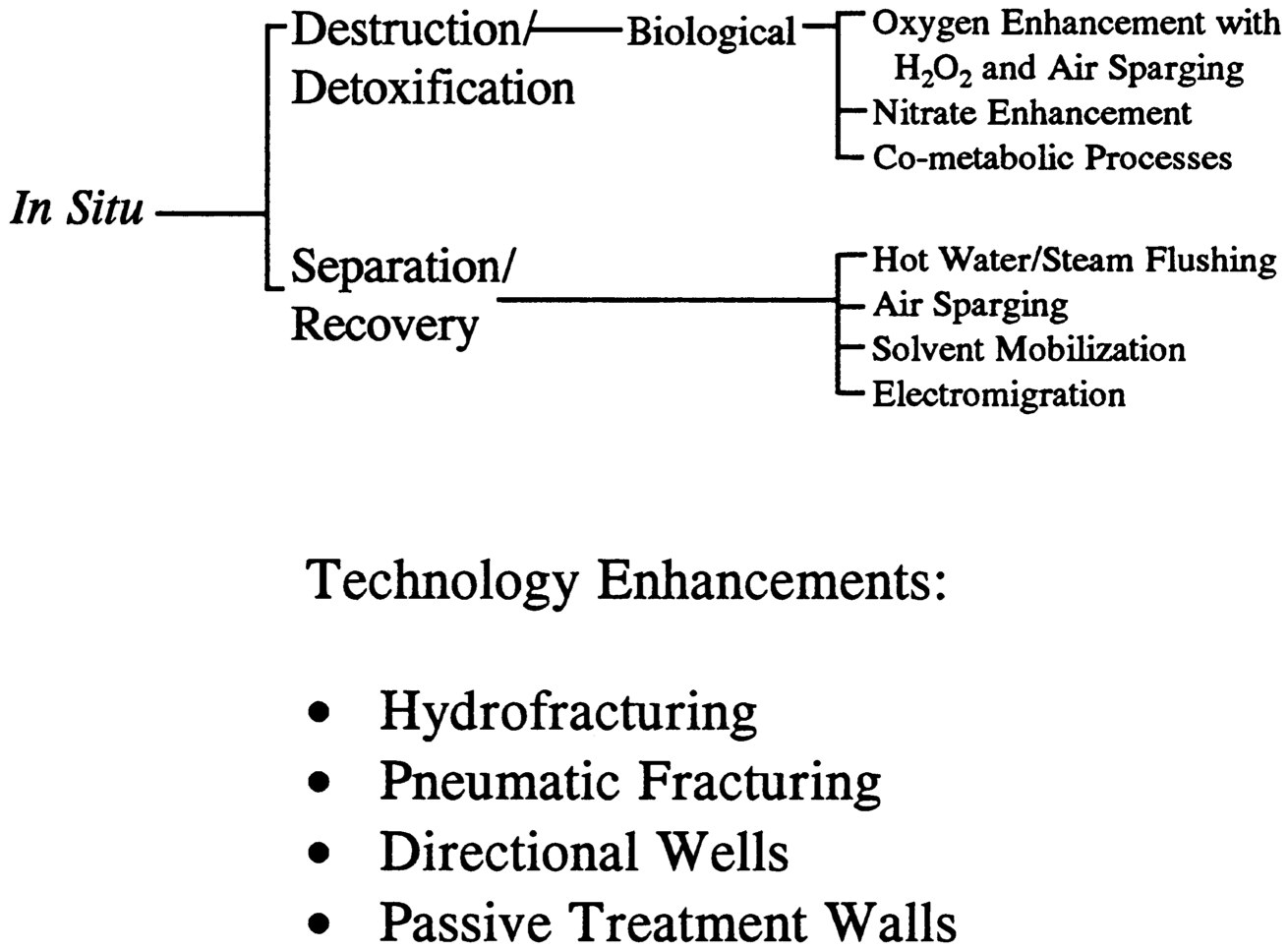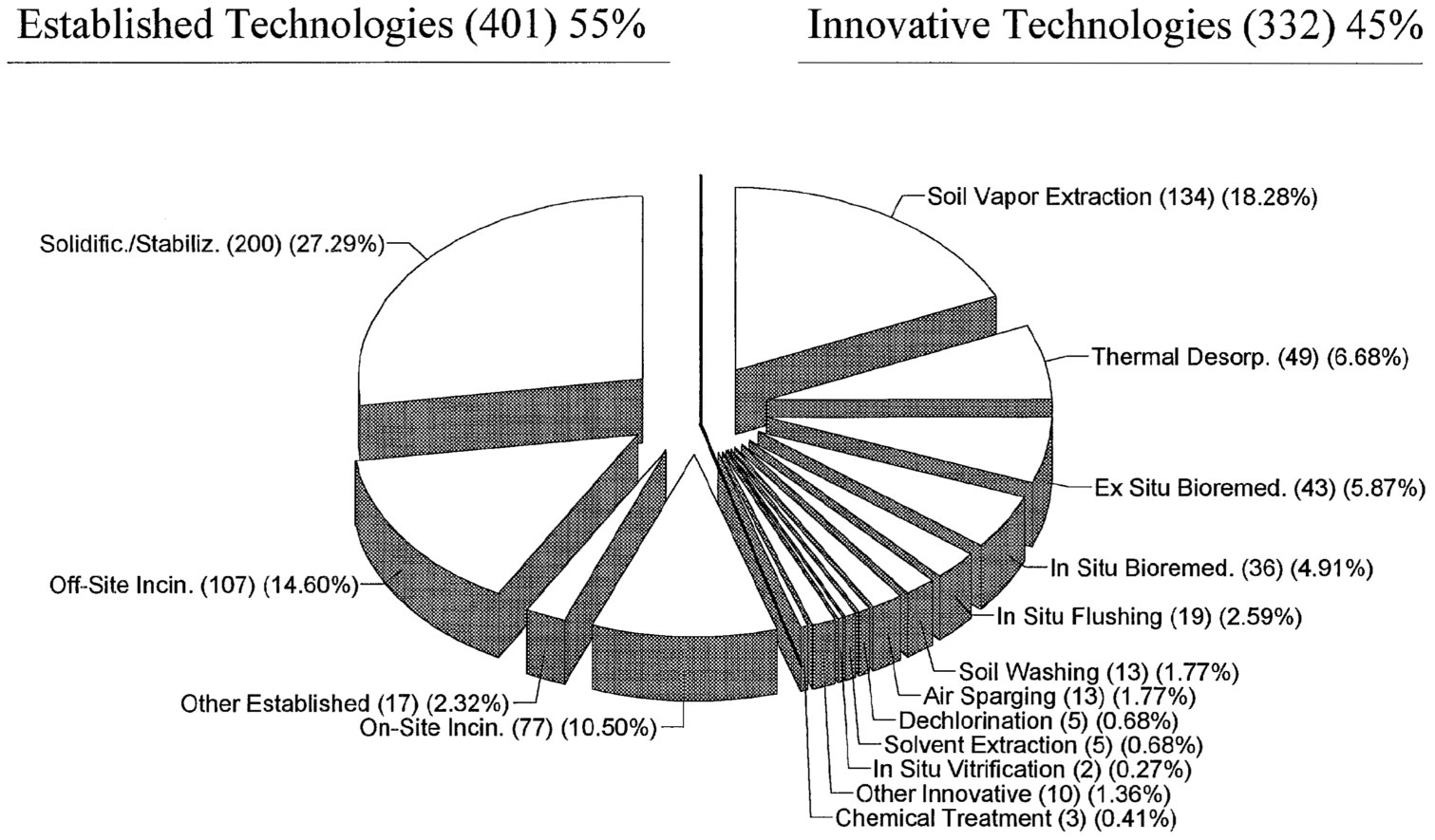4
Remediation
INTRODUCTION
Although the USGS is unlikely to become directly engaged in either developing or implementing technologies for remediation, it is likely that the USGS increasingly will be called on to support cleanup efforts by providing high quality data on natural systems and processes necessary for the proper design of remediation options, and to evaluate the efficacy of remediation efforts through field measurement programs. Moreover, the USGS is well positioned to further understanding of intrinsic bioremediation, the process that occurs when natural conditions at a contaminated site promote in situ bioremediation in the absence of engineering intervention. With appropriate monitoring, intrinsic bioremediation can be a successful treatment strategy if the rate of contaminant destruction outpaces contaminant migration such that the contaminant plume shrinks over time without causing a significant threat of exposure. Thus, it is considered appropriate for the USGS to participate in the identification and solution of problems associated with remediation of contaminated land and water resources. This chapter briefly reviews the state-of-the-art of remediation technology and monitoring, identifies critical areas for remediation research, and describes specific research opportunities where the USGS can contribute to meeting the challenges of remediation contaminated sites.
STATE-OF-THE-ART IN THE FIELD
Remedial technologies can be grouped into the following categories, based upon levels of development as well as effectiveness in providing environmental remediation.
-
Emerging Technology. A technology that requires additional laboratory or pilot-scale testing to document the technical viability of the process.
-
Innovative Technology. A technology for which cost or performance information is incomplete, thus impeding routine use. An innovative technology may require additional full-scale field testing before it is considered proven and ready for commercialization and routine use.
-
Established/Available Technology. A technology that is fully proven, in routine commercial use, and for which sufficient performance and cost information is available.
The development and application of many remedial alternatives has occurred largely in response to the mandates of state and federal regulations such as “Superfund” (CERCLA and SARA), as discussed in chapter 2. The range of options that has become available includes emerging concepts with bench-scale testing, field demonstrations, and techniques approved for full-scale use and commercialization. For example, the state of technology development for options applicable to soils, sediments, ground waters, and other matrices (Table 4.1) includes both ex situ and in situ techniques that are based on biological, physical, and chemical processes, either in separate or combined systems. Technology applications for soils, sediments, and ground waters have been, or are being developed to destroy, detoxify, separate, recover, or immobilize contaminants according to their functional identity (Figure 4.1 and Figure 4.2). Many of these same technologies also may be applied to sludges and dredge spoils. In addition, augmentation and/or enhancement may be required to optimize in situ biological and physical-chemical techniques, and in situ immobilization may be but one consequence of an applied technology rather than its primary intent. Therefore, techniques for contaminant access, isolation or capture, as well as extraction and ex situ
Table 4.1 Status of Remedial Technologies (Soils, Sediments, Sludges, Ground Waters, and Solid-Matrix Wastes)
|
Emerging |
Innovative |
Established/Available |
||
|
Bench-Scale Testing |
Field Demonstration |
Selected for Remediation |
Limited Full-Scale Use or Limited Data |
Common Full-Scale Use |
|
In situ electrokinetics |
Radio-frequency heating |
Solvent extraction |
Thermal desorption Land treatment |
Incineration Solidification/stabilization |
|
X-ray treatment |
Ex situ furnace vitrification |
In situ soil flushing |
Soil vapor extraction |
Above-ground treatment |
|
Electron irradiation |
Pneumatic or hydraulic fracturing |
Dechlorination Bioventing |
Soil washing |
|
|
Laser-induced oxidation |
Treatment wall |
Air sparging |
In situ bioremediation |
|
|
Slurry-phase bioremediation |
||||
|
In situ vitrification |
||||
|
Source: U.S. Environmental Protection Agency, 1994; Kovalick, 1994; and WASTECH, 1995. |
||||

FIGURE 4.1 Technologies applicable to soils and sediments.
aqueous-phase treatment, may provide supplemental alternatives for an integrated remedial approach.
New remedial technologies continue to be developed (WASTECH, 1995), and the use of innovative options has already surpassed established or conventional alternatives for remediation at Superfund sites. There has been a significant trend toward innovation as new technologies are demonstrated and applied for the remediation of contaminated ground waters,

FIGURE 4.2 Technologies applicable to ground waters.
soils and sediments (Figure 4.3 and Figure 4.4). Moreover, depending on site-specific circumstances, more than one technology or process may be needed to achieve remediation goals. Combinations of technologies that have already been implemented at Superfund sites include (U.S. Environmental Protection Agency, 1993a, b):
-
soil washing, followed by bioremediation, incineration, or solidification/stabilization of soil fines;
-
thermal desorption, followed by incineration, solidification/-stabilization, or dehalogenation to treat PCBs;
-
soil vapor extraction, followed by in situ bioremediation, in situ flushing, solidification/stabilization, or soil washing to remove semivolatile organics;
-
dechlorination, followed by soil washing for inorganics;
-
solvent extraction, followed by solidification/stabilization or incineration of extracted contaminants and solvents;
-
bioremediation, followed by solidification/stabilization of inorganics; and
-
in situ flushing, followed by in situ bioremediation of organic residuals.
Nearly 50 emerging, innovative, or established/conventional technologies have been identified for contaminated soils, sediments, sludges, and ground waters (U.S. Environmental Protection Agency, 1993b). Many include in situ and ex situ biological, thermal, physical, and chemical processes, which are supplemented by techniques primarily used for containment, separation, or enhanced recovery or off-gas treatments. Each involves a variety of challenges, including cost, performance, technical, developmental, and institutional issues. Collectively, these challenges constitute screening factors influencing the efficacy of a particular remedial technology, and range from overall cost to community acceptability. Some of these factors pose performance-related questions, whereas the others present opportunities to assign comparative ratings (i.e., better, average, worse, or inadequate information) based on available knowledge, experience and expertise. Such an approach has led to the development of an interagency DOD/EPA remedial technologies matrix (U.S. Environmental Protection Agency, 1993b), and resource documents that describe remediation case studies (U.S. Environmental Protection Agency, 1995).
CRITICAL AREAS FOR RESEARCH
Technology development and deployment are in considerable flux, even for those technologies ranked as having full-scale or conventional status. Further, technologies currently not highly rated in terms of various screening factors may become attractive in the future as more is learned. There is considerable opportunity for additional discovery in terms of basic scientific principles and their applications to remediation, whether for characterization of processes or the environmental setting that
is the ultimate target for remediation. For example, heterogeneities within hydrogeological environments, and the complexities of contaminant partitioning behavior, can hinder the effectiveness of remediation technologies in the field. Therefore, in order to improve understanding of contaminant transport and fate within natural systems, research priorities should emphasize studies that employ direct measurements from field investigations rather than from more easily controlled laboratory experiments.
A research area that would have major impacts on improved application of in situ remediation technologies is the development of methods for evaluating remediation success or progress in the field. Currently, evidence that applied remediation technologies are responsible for the removal or detoxification of contaminants is difficult to collect and rarely convincing (National Research Council, 1993 and 1994b). Similarly, as the limitations of currently applied physical, chemical, and biological remediation processes, including the uncertainties of retardation, attenuation, and/or mobility enhancement mechanisms, become more evident through the increasing numbers of laboratory field demonstration studies, it will become clear that future priorities in field-scale development should be directed toward application of combinations of remediation technologies or remediation technologies that are designed to work together with natural attenuation processes. Growing out of these integrations will be the need to understand the complex responses resulting from multiple processes, in order to more confidently evaluate the overall effectiveness of complex remediation schemes.
OPPORTUNITIES FOR THE USGS
The research challenges associated with remedial technologies represent an important avenue of opportunity for the USGS, because the experience and expertise required to assess and characterize the nation's water resources as impacted by hazardous materials are the same as those needed to successfully engage in the assessment of the effectiveness of remediation. Therefore, the USGS should embark on a focused strategy to position itself as an active participant in decisions that involve environmental assessments associated with contaminated soils, sediments,
ground waters, and surface waters, and the application of innovative technologies for effective remediation. This strategy is consonant with the USGS's general objective to expand the body of scientific knowledge relevant to the behavior of hazardous materials in the environment.
The USGS, as the principal federal nonregulatory organization charged with investigating water resources problems, is positioned to extend its national agenda beyond characterization of contaminants and their transport and fate in the natural environment, to the science and technology of source remediation. This added dimension is justified because one of the historical strengths of the USGS has been its long-term involvement in field research. In the area of hazardous waste remediation, field research should continue to have a high priority, with the understanding that laboratory studies that support work in the field will also be necessary and beneficial.
In establishing an agenda for future research emphasis, the USGS should not specifically direct efforts towards the development of new remediation technologies, but should capitalize on its field experience and research capabilities in evaluating the effectiveness of technologies developed and implemented by others. Because the USGS is not directly associated with contaminated site liability or directly responsible for cleanup, it should play a significant role in providing objective and unbiased assessment of results. This will require close coordination among researchers involved in diverse applications. For example, researchers studying metals transformation in anoxic sediments may greatly benefit by frequent communication with those studying acid mine drainage in surface waters and vice versa.
The programmatic structure of the USGS also is well suited to integrating short- and long-term field studies with directed laboratory research in the area of hazardous materials science and technology. The Federal-State Cooperative Program supports specific site-related studies that are short term and may include site characterization and monitoring as well as the evaluation of remedial technologies. The evaluation of more broadly applicable field methods and techniques may be funded by the Department of Defense Environmental Contamination Program, whereas the Core Hydrologic Research and Toxic Substances Hydrology Programs provide long-term funding that supports scientific work with more prospective potential. Thus, the potential for integration of exper-













